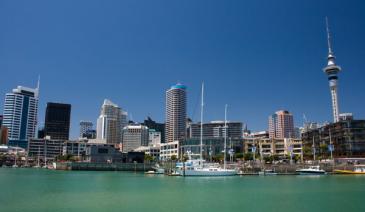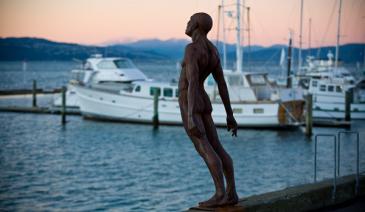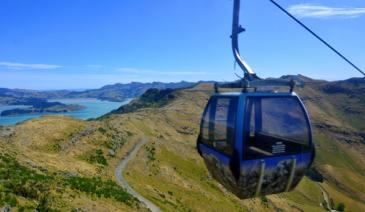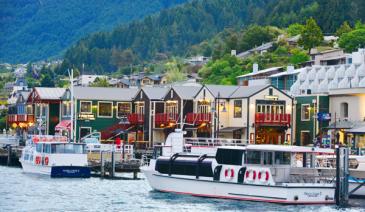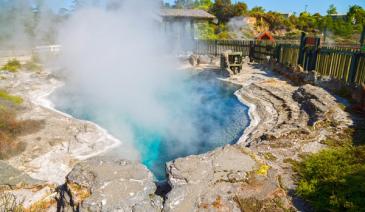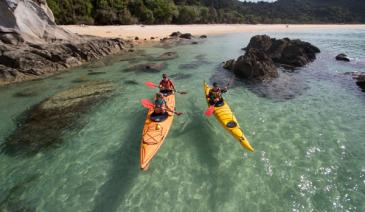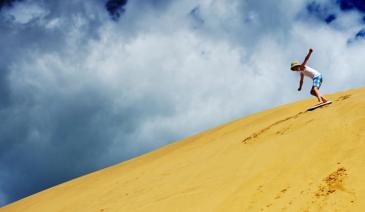Nelson & Golden Bay, Walks & Parks
-

Wainui Falls Track
The 30-minute walk to Wainui Falls is popular as accessible waterfalls are not common in Golden Bay. The track starts from a car park in Wainui Bay 20 km north-east of Takaka. Look for the direction sign on the road side approximately 300 metres after crossing over the Wainui River Bridge. From the car park the track crosses farmland for a short distance before entering forest and climbing rapidly to a point where you see the river surprisingly far below. Here you walk through a forest of nīkau palms, rātā trees and ferns. Keep a lookout for a possible sighting of the giant snail, Powelliphanta. Look but don’t touch! A few minutes after crossing the swingbridge over the Wainui River, you will hear the falls before they suddenly appear, usually curtained in spray. Children need to be closely supervised as there are steep drops off the edge of the track in some places. Take a picnic, there are a few little beaches perfect for a swim, picnic and a bit of boulder hopping.
read more- Location: 29 Wainui Falls Rd, Tata Beach 7183
-

Beaches - Nelson region
The Nelson region has endless golden beaches ideal for swimming, sailing, windsurfing, kite surfing etc. Some of our top picks are: • Tahunanui beach, Nelson – great for families. Safe swimming and plenty of other activities nearby for the kids. Great place for a picnic or BBQ. • Kaiteriteri - three great beaches on your doorstep, all safe for swimming, perfect for family holidays. • Cloudy Bay – unspoilt and quiet beach. Check out the rest of the coastline too. • Golden Bay - lots of safe swimming beaches. The golden sand beaches start East of Tarakohe harbour. The shallow tidal beaches like Pohara, Ligar Bay can be very warm when the tide comes in over the warm sand. If the tide is out, Tata beach always has deep water and this is a great swimming beach. • The walk to Taupo Point in Abel Tasman National Park (about 1 hour and at mid to low tide) passes some lovely beaches. • Totaranui beach, western end of the Abel Tasman National Park – stunning! • Wainui - secluded and can be more sheltered from any westerly winds
read more -

Rabbit Island Recreation Reserve - Nelson
A popular beach and picnic spot, 15 minutes drive west of Nelson. The island is reachable by a bridge that crosses the estuary behind the island. Most of the island is pine plantations, with a public picnic area in the middle of the front beach. Toilets, changing rooms and outside showers are at the beach. Also picnic tables and coin operated BBQs. The gates are closed at sunset and overnight stays are not allowed so be ready to leave before it gets dark. There is a large sign near the entrance which lets you know what time the gates will be closing that day (in the middle of summer it’s around 9pm).
read more -

Farewell Spit - Golden Bay
Situated at the northwest tip of the South Island, the distinctive Farewell Spit curves round Golden Bay – at 25km it’s the longest sand spit in NZ and is very visible from the air. As a nature reserve, Farewell Spit is known internationally and over 90 bird species are recorded in the area. Farewell Spit has also unfortunately witnessed several incidents of mass whale beachings over the years. Despite an enormous local turn out to attempt to save the whales, these beachings have often resulted in a saddening death toll.
read more -

Speargrass Track Hut
For an easy overnight tramp, great for kids, walk to Speargrass Hut on this well graded track. 2 hr 30 min one way - this well graded track descends gradually from the carpark. It follows the river along the valley floor then climbs up through beautiful beech forest to Speargrass Hut ( 12 bunk beds) – set in clearing with mountain views.
read more- Location: Mt Robert Road, off SH 63 east of St Arnaud.
-

Farewell Spit - Wharariki Beach
One of the most beautiful beaches in the region – huge sand dunes, lagoon, caves, seals, birdlife and no roads nearby! Access is by easy path – from the end of Wharariki Road, walk over farmland and through a section of coastal forest to the beach. Please do not approach seals. Be aware of weather conditions and sea and surf can be rough. Fossil Point Loop – easy 1 hr return From the carpark, walk across Triangle Flat to see fossils in the mudstone and seals in the water. Return via Ocean Beach and a vehicle track. Pakawau Beach Good family swimming beach with shallow, warm waters. 15 minutes north of Colllingwood. Watching the speed of the tide flow into or out of the inlet is an experience in itself!
read more -

Takaka Hill Walkway
Takaka Hill Walkway is a loop walk at the top of Takaka Hill. The walkway passes through fascinating karst landscape, with intriguing marble rock formations, beech forest with magnificent views of Kahurangi National Park and Golden Bay. Length: 3 km for half loop; 5.1 km for full loop, Time Required: 1-2 hr for half loop; 2-3 hr for full loop. The loop track is located at the top of Takaka Hill on State Highway 60, 53km from Richmond and 38 km from Takaka. There is a car park off the side of the road which is well signposted.
read more- Location: 1147 Takaka Hill Hwy, Takaka Hill 7198
-

Kaituna Track
Kaituna Track begins approximately 15 km from Collingwood. Follow the main road from Collingwood to Bainham inland to where Carters Road begins, on a tight corner. The car park is at the end of the road. The track starts from the car park at the end of Carters Road and continues right through to Westhaven Inlet on the West Coast (8–9 hours). Most people, however, walk only to the site of the old Kaituna gold workings (20 min) or on to Kaituna Forks, a 2-hour return trip. The Kaituna Goldfield was first worked in 1859 and continued until the late 1800s, although little gold was ever recovered. The present track follows the original packhorse track to the Kaituna goldfield. From the car park, cross Little Granity Creek using the footbridge and follow the farm track for 400 metres to the start of the walk. A short track takes you past the remains of gold- sluicing operations, water races, tailing piles and a small cave. The side track then cuts back onto the main track. Beyond the Kaituna Forks, the track changes to a ‘route’ and is suitable only for experienced and fit trampers. At the forks there is a river crossing which is impassable in flood. From here it is a further 5–6 hours over a marked route to Knuckle Hill. Beautiful native forest and gold-mining relics are the main attractions of the Kaituna Valley. Magnificent specimens of northern rātā, pukatea and rimu tower over a sub-canopy of nīkau palms, heketara, wineberry, kāmahi, and māhoe. The rich forest and mild climate allow a wide range of birds to flourish: kererū (the New Zealand pigeon), tūī, fantail, tomtit, bush robin, rifleman, silvereye and bellbird.
read more- Location: Carter Road, Collingwood
-

Pupu Hydro Walkway
Pupu Hydro Walkway (Loop 1 hr 50 min) begins 9 km from Takaka at the end of Pupu Valley Road. Follow the road towards Te Waikoropupū Springs, turning off to the right just before the bridge crossing Waikoropupū River. The Pupu Hydro Walkway retraces an old gold-mining water race, which has been reused for power generation. Botanically the walkway is very interesting, bird life is plentiful, and the history is fascinating. Although the climb to the water race line is a little steep, the first section, across Waikoropupū River to the power station, is an easy grade suitable for all ages. Beyond the power station the track crosses Campbell Creek and zigzags upwards to reach the race after about 30 minutes’ climb. From here the track levels out and follows the race ‘upstream’ for a short distance to a lookout point above the power station. From here on you are strongly advised to carry small children in a backpack and watch other children carefully; a fall from the race and the water itself are potentially dangerous. The water race, which follows the steep contours of the hillside and is part canal and part aqueduct, was an engineering masterpiece for its time. If you look carefully in the water you might see large kōura (freshwater crayfish). Follow the race for 30 minutes or so to the weir (the water intake), which marks the end of the walkway and is a beautiful picnic spot. The weir channels water from the creek into the race; a large shutter was raised or lowered to vary the amount of water taken from the stream. The Hydro Society 4WD vehicle access track from the weir makes the walkway a loop walk (50 min) back to the car park.
read more- Location: Pupu Valley Rd, Tasman Takaka
-

Te Waikoropupu Springs
read moreFollow State Highway 60 north from Takaka on the road to Collingwood, turning left just beyond Takaka River. Follow Pupu Valley and Te Waikoropupū Springs roads to the springs’ car park, 7 km from Takaka.
Te Waikoropupū Springs are New Zealand’s largest freshwater springs and the largest coldwater springs in the southern hemisphere. They contain some of the clearest water ever measured and are set in a reserve
that protects gold workings, regenerating forest and a fine patch of mature bush. To Māori the area of Te Waikoropupū is a taonga or treasure and a wāhi tapu, a place held in high cultural and spiritual regard, both locally and nationally. The legends of Te Waikoropupū are told in the stories of Huriawa, its taniwha (guardian spirit). In Māori tradition the springs are waiora, the purest form of water and provide water for healing. In the past, the springs were a place of ceremonial blessings at times of birth and death and the leaving and returning of travellers. A platform that sits partly over the water allows visitors to get a good view of the springs. A suite of interpretation signs at the entrance way tells the full story of this fascinating and beautiful place. Well-formed walking tracks allow you to explore the reserve. Allow 30–45 mins to visit the springs and return. It is worth spending extra time to enjoy the interpretation signs at the entrance.- Location: Pupu Springs Rd, Takaka 7183
-

Aorere Goldfields Track
Aorere Goldfields Track is a 3-hour loop (9km from Collingwood), which gives you access to explore some of the more accessible gold-mining remnants, including the Slate River Sluicing Company Dam (‘Druggans Dam’) and the Aorere Caves. Boots and a degree of fitness are recommended. As there is little shade along the track, sun protection is also required. From the car park a 4WD track passes an old ground–sluicing claim worked in the 1880s and continues onto the large open area partly covered by pākihi vegetation, which is Druggans Flat. From here the track climbs steadily, passing a side track that leads to the untouched bush of Stanton’s Creek. It then follows part of the original benched miners’ track. At the first junction, continue straight ahead. On the right you pass the end of a water race and a tunnel before the short side track to Stafford’s Cave. Stafford’s Cave and Ballroom Cave (accessed by short side tracks a little further on) can both be explored if you are equipped with appropriate clothing, a torch and some care. Early miners recorded their names on some of the formations within these caves; please take care not to disturb these. Ballroom Cave is reputed to have been used by miners as avenue for dances. From here it is another 20–30 minutes to the dam. On a fine day your effort is rewarded on this section of the track with excellent views of the Wakamarama and Burnett ranges, Ruataniwha Inlet and north to Farewell Spit.
read more- Location: Aorere Goldfields car park, Devils Boots Rd. Rockville.
-

Rawhiti Cave Route
Rawhiti Cave has possibly the most diverse and extensive entrance and twilight-zone flora of any cave in New Zealand. This flora influences the growth of calcium-based features in the cave; hence the stalactites on the cave ceiling grow outwards towards the sunlight.. You can walk onto a viewing platform just inside the cave entrance. From Takaka, drive east towards Pohara Beach. At Motupipi, turn right into Glenview Road and then left into Packard Road. Rawhiti Cave is signposted from near the end of Packard Road. A rough track follows the legal road through farm land to an informal car park. Please leave the gates as you find them. It takes approximately 15 minutes to drive from Takaka to the carpark. Just after you leave the car park you cross Dry River. After heavy rain, this river is prone to flooding: do not attempt to cross in these conditions. From here, the marked route continues up the valley for 30 minutes and turns sharply right. It then climbs steeply for a further 30 minutes, zigzagging up to the cave entrance. The last section of the track is steep and narrow; reasonable fitness and tramping experience is required for this section.
read more- Location: Packard Rd, Takaka 7183
-

Knuckle Hill Track
Head west from Pakawau over the Pakawau Saddle and down to Whanganui Inlet. Dry Road leads around the inlet, crossing several tidal streams before climbing to a car park at a saddle with a great view of the inlet mouth. Knuckle Hill Track is signposted from the car park. This aptly named hill provides the only elevated viewpoint over Whanganui Inlet, a huge estuary declared a marine reserve and wildlife management reserve in 1994. From the car park, an old logging road climbs gently through regenerating forest to a clearing, where there is plenty of space to relax and picnic. This 5.6-kilometre section of road takes about one hour to walk or a little less to mountain bike. At the clearing, the marked route up Knuckle Hill begins — a short climb of 20 minutes. From the top, right on the boundary of Kahurangi National Park, are excellent views of the top of the South Island, particularly Farewell Spit and Whanganui Inlet.
read more- Location: Knuckle Hill, Kahurangi National Park 7073
-

Paynes Ford Scenic Reserve
Paynes Ford Scenic Reserve is located along State Highway 60, 3 km south of Takaka. It takes its name from the original ford across the flood-prone Takaka River on the main road into Takaka. A modern bridge now replaces the ford. With its impressive line of limestone bluffs emerging from a remnant patch of forest, Paynes Ford is one of New Zealand’s best rock-climbing areas. Climbers come from far and wide to enjoy the challenge of the sheer rock faces — these are definitely not for beginners! Non-climbers will enjoy a visit to the reserve to picnic, swim, walk or watch the climbers. There is a large picnic area beside the highway bridge. At the southern end of this area is a toilet, where the Paynes Ford Tramline Track (a 30-minute walk) begins. The track provides access to the climbing areas and some excellent swimming holes in the Takaka River. It follows the line of a railway that operated between the early 1880s and 1905 and was used to take timber from the Takaka valley down to Waitapu wharf.
read more- Location: 1886 Takaka Valley Hwy, Takaka 7183
-

Kaihoka Lakes
At Pakawau, turn left off the main road and head over Pakawau Saddle, turning right on to Kaihoka Road just before Whanganui Inlet. Follow this road for 6 kilometres to Kaihoka Lakes Scenic Reserve. Coastal hills form a dramatic backdrop to these beautiful lakes. A 10-minute walking track begins beside one lake and heads gently down to the other. There is space to picnic at the car park and further along the road next to the lake. The reserve is distinguished by its massed nīkau palms, which give the walk a tropical feel. Here and there, dense glades of young mataī, kahikatea, cedar and tānekaha indicate that the forest is recovering after past disturbance. Large, carnivorous Powelliphanta snails live in the reserve and a variety of water fowl can be seen on the lakes. Shags, paradise ducks, Canada geese and grey ducks all find shelter there among the raupō (bullrushes) and reeds.
read more- Location: 342 Limestone Road, Pakawau Saddle, 7073
-

Lions Playground and Tahunanui Beach
This walk takes in Nelson's premier children's playground - the Lions Playground. Time: 50 - 70 minutes walking. The playground time is over to you! Easy walk over sand. Check the newspaper for tide times when planning this walk. This walk goes past a rollerskating area, and Nelson Fun park as well as havong a BMX track close by. Bring a picnic and make a day of it. Start: Tahunanui Reserve car park by the Lions Playground. Cross the playground and head to the left on Tahunanui Beach. There's plenty to interest children on the beach, and in summer (or a fine winter's day) you can swim. The view of ships coming and going from the port is impressive and if you're taking an evening stroll, the sunsets are a treat. Turn left when the main beach ends and head down the Back Beach to the point where the sand hills end at the entrance to a small inlet. From here wander through the trees back towards the carpark.
read more- Location: Tahunanui Beach, off Rocks Road, Nelson
-

Abel Tasman National Park
New Zealand’s smallest National Park at just 225sq km. Both the inland and coastal tracks are famous for their outstanding beauty, and it’s very easy to take the family on small sections of the coastal track (total is 51km), walking for anything from an hour, half or full day. You can then arrange to pick up a water taxi back to Marahau or Kaiteriteri. The track starts at Marahau, just outside the Park Café. From here you walk along the boardwalks for about 5 minutes, to the start of the actual track. Short walk - the first section of the track is very easy and you can be picnicking on a secluded beach within 20 minutes, admiring the turquoise waters, golden sand and inquisitive birdlife. Other walking options - If you carry on to the first hut on the track, at Anchorage Bay, you’re in for a stunning walk but it’ll be 4 to 5 hours. Water taxis have a scheduled pick up from Anchorage to Marahau, and the last departure is around 3.30pm. Check this before you leave, or book a personalised pick up service. Water taxi cruise / walk – all water taxi companies also offer tours where you can be dropped off at a scenic section of the park and walk for a few hours before you are picked up again. See individual companies for more details.
read more -

Cable Bay Walkway
Enjoy the coastal views on this walkway between Rotokura/Cable Bay and The Glen, near Nelson. Boating, sea kayaking, and snorkeling are all possible. Cable Bay Walkway extends from Glenduan to Cable Bay, north of Nelson City. The hilly coastal track passes through a mix of pasture, pine forest and native forest, and provides impressive views of Tasman Bay and Cable Bay. The walk can be completed in either direction and is best enjoyed if you have someone to pick you up at the other end. The complete walk takes about 3½ hours one way, and requires transport arrangements to be made. From the Rotokura/Cable Bay end a shorter return trip is to the top of the first hill (1 hr return) or to the forest edge (2 hr return). From the Glen end, a round trip to the airstrip and back takes about 2 hours. Cable Bay Walkway offers wonderful coastal views of the Boulder Bank, Nelson City and Kahurangi and Abel Tasman National Parks. The middle section of the track passes through a patch of beautiful and varied native forest.The track is a walking track. It is steep in places and strong footwear is recommended.
read more- Location: Airlie St, Glenduan, Nelson
-

Botanical Reserve and the Centre of New Zealand - Nelson
The geographical "Centre of New Zealand" allegedly lies in Nelson; on a hilltop suspiciously convenient to the centre of the city. This supposed "centre" in fact simply marks the point deemed the "centre" for the purposes of early geographical surveys. The true geographical centre lies in a patch of unremarkable dense scrub in a forest on the Spooner Range near Tapawera, 35 kilometres southwest of Nelson. However, the “Centre of New Zealand” is a landmark, it makes for a great walk and fantastic viewpoints, and it’s easy access from the city! This is one of Nelson's most popular walks. Enter the Botanical Reserve over a footbridge at the end of Hardy Street, and follow the signs and interpretive panels from there. There are numerous other tracks so you can make a loop by going downhill by another path. A good route back is to head east to Branford Park and take the Matai Track back to your starting point. Playgrounds, toilets and picnic tables in the reserve.
read more -

The Grampians - Nelson
The Grampians are a prominent group of hills rising steeply behind Nelson City. Named after the mountain range in Scotland, the tallest point reaches 390 m and is notable for havin... read more
- Location: Upper Collingwood Street, Nelson
-

Labyrinth Rocks Walkway
Just two kilometres out of Takaka, on the way to Pohara, are three big oak trees. Turn left here, follow the signs to Labyrinth Rocks Walkway and you will find one of Golden Bay's most amazing places. Nature has produced a maze-like network of canyons through a limestone outcrop " an excellent example of the geological term 'Karst' limestone for which this area is known. It has been developed (and is still in the process of being developed) as an enchanting family attraction. Young or old, you will love exploring all the nooks and crannies - keep younger kids close to you as you can get lost in the maze, older kids will enjoy going off and trying to find their way back. A magical thing to do - is see if you can find little toys and figurines hidden in the rocks - it's the locals kids secret toy swop. So if your child brings their own figure/toy (check out the Salvation Army shop in town), your child can find one they love they can take it and leave theirs in its place! They will be begging to go back the next day.
read more- Location: 7183, 45 Scott Rd, Takaka 7183
-

Sylvester Hut Track
Walk up to Sylvester Hut as day walk or overnight tramp with children - enjoy great views from the hut and explore a series of lakes on the open tops behind the hut. Sylvester Hut is an easy-ish two hour climb on an old 4WD track from a small carpark over the Cobb Dam, through beech forest until you get out onto the tussock tops. Not far away are the pretty Lake Sylvester and a few smaller alpine tarns. There is a major view to the east, D’Urville Island in the Marlborough Sounds, the Richmond Range. You can even see Mt Taranaki on a clear day. Sylvester Hut is one of the best bang for your bucks around: close to the road, great hut, excellent views.
read more- Location: Cobb Dam Rd, Kahurangi National Park 7073
North Island
South Island

- Central Otago
- Auckland
- Bay of Plenty
- Christchurch
- Dunedin
- Coromandel
- Gisborne
- Fiordland
- Hawkes Bay
- Marlborough Sounds
- Manawatu
- Nelson & Golden Bay
- Northland
- North Canterbury
- Queenstown
- Rotorua
- South Canterbury
- Taranaki
- Southland
- Taupo
- Wanaka
- Waikato
- Wellington
- West Coast
- Whangarei
- Bay of Islands
- Tauranga
- Gisborne
- Hamilton
- Napier
- Kapiti
- Palmerston North
- Whanganui
- New Plymouth
- Arrowtown
- Te Anau
- Akaroa
- Ashburton
- Hanmer
- Kaikoura
- Methven
- Mt Cook
- Oamaru
- Tekapo
- Timaru
- Abel Tasman
- Motueka
- Nelson Lakes
- Blenheim
- Picton
- Catlins
- Gore
- Stewart Island
- Central Plateau
- Invercargill
- Cromwell
- Greymouth
- Hokitika
- Westport
- Glenorchy
